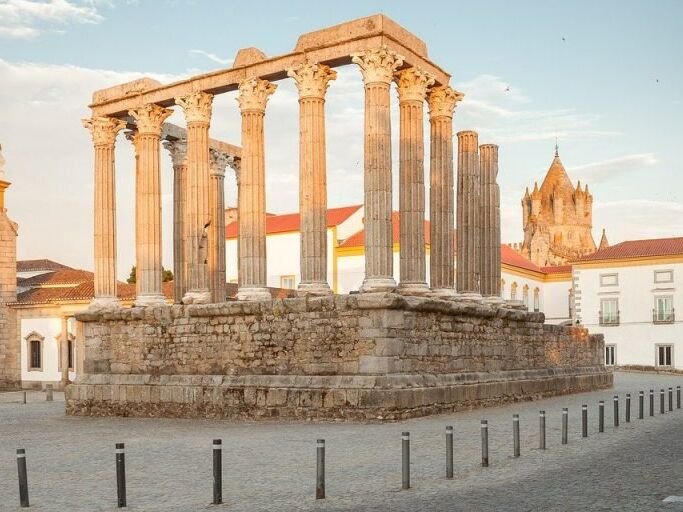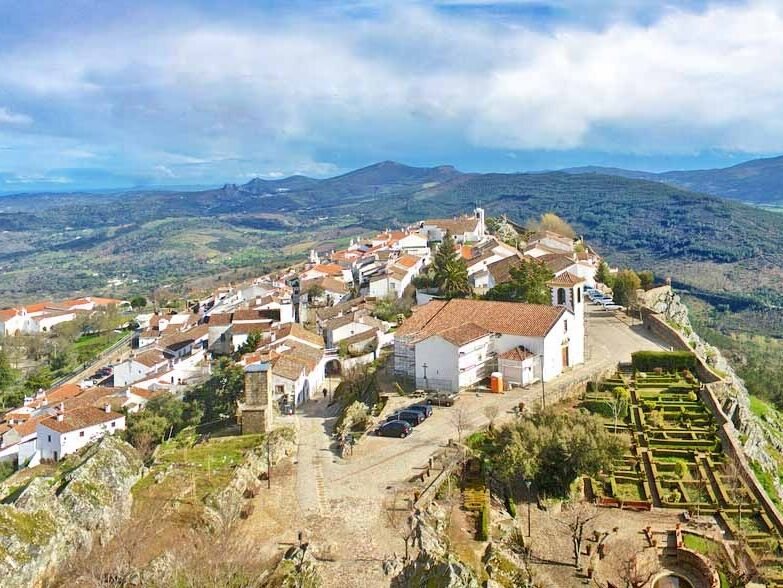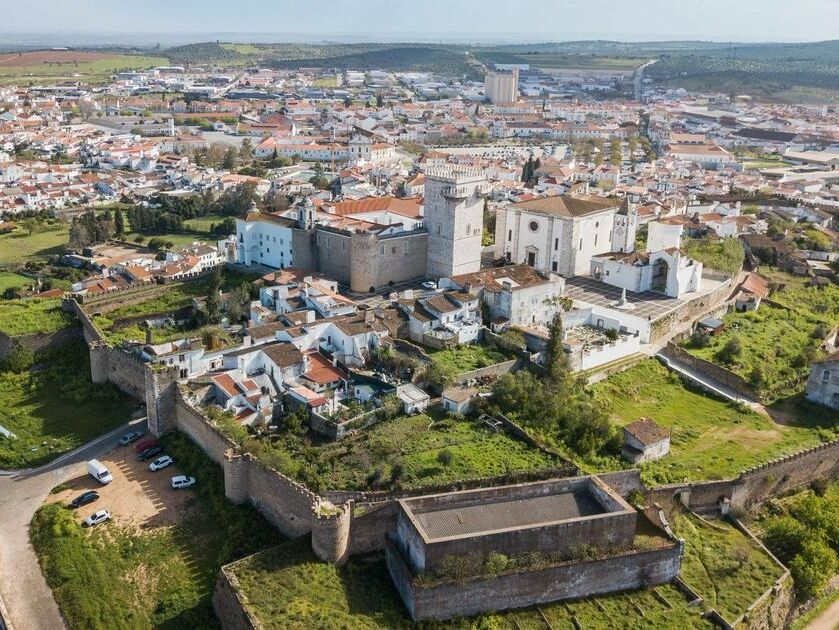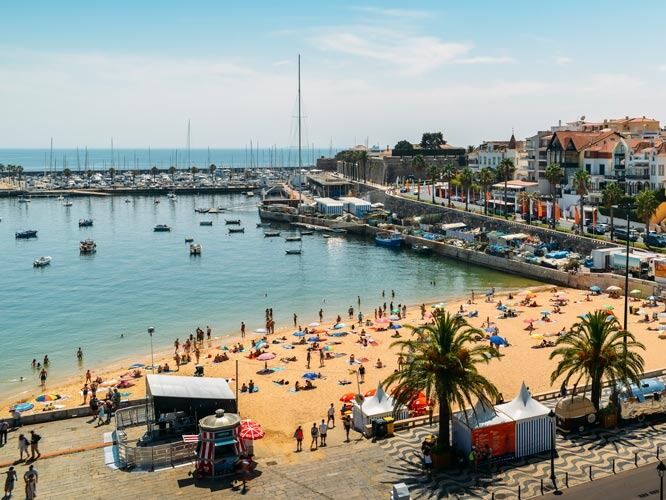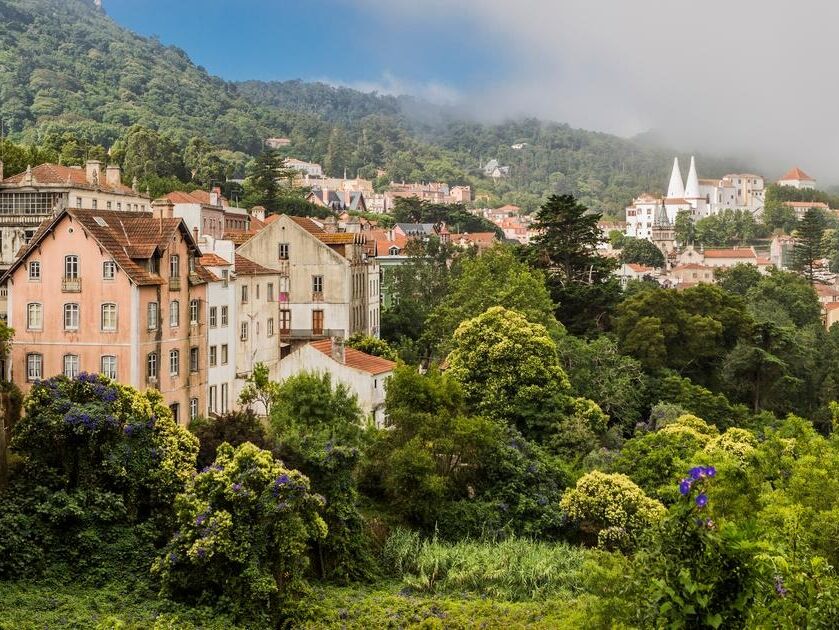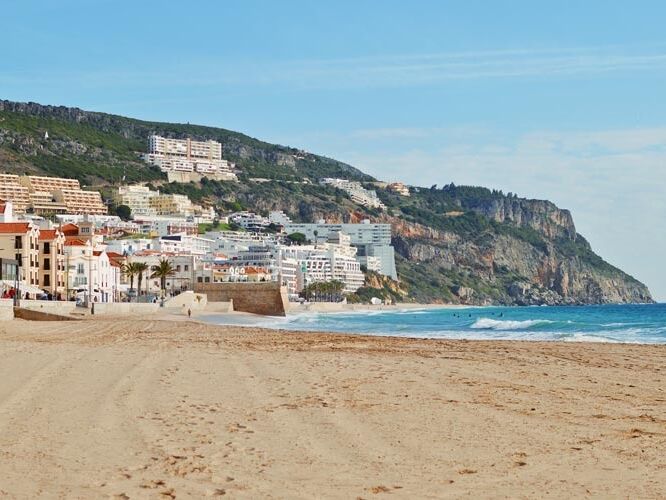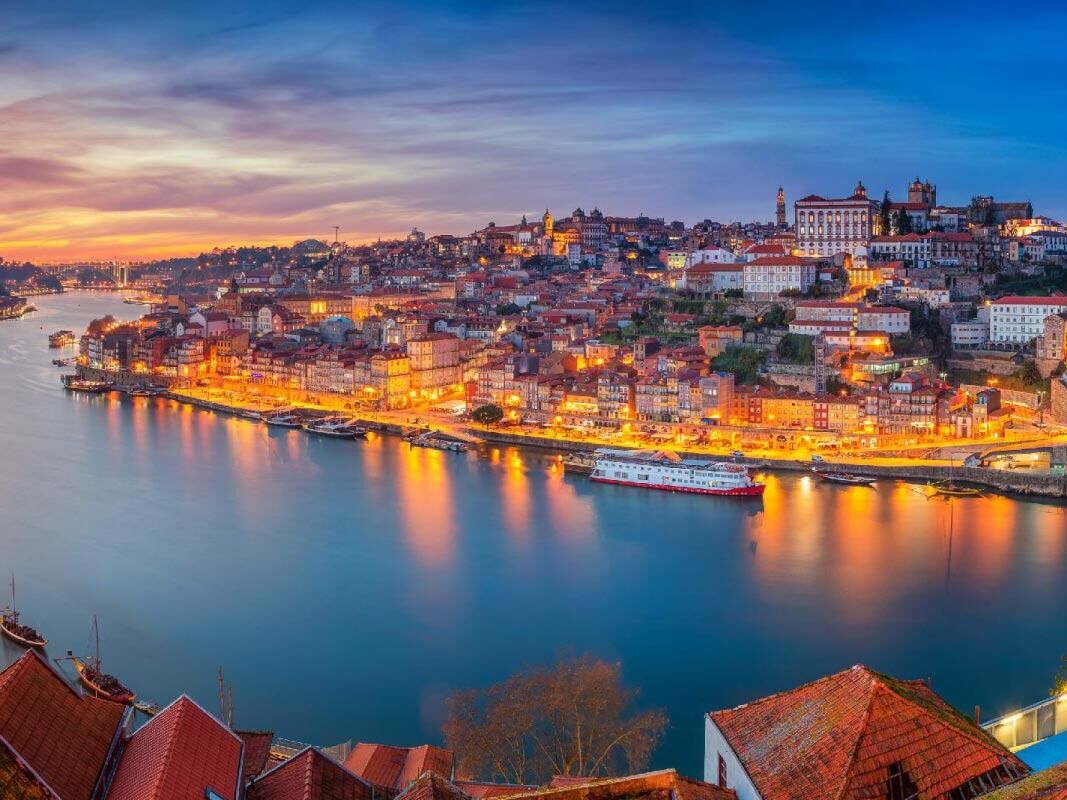Asha & Ricardo
Asha & Ricardo
Things to Do
_______________________________
Alentejo (Venue/Local)
_______________________________
Elvas
Sightseeing: Aqueduct; walls; forts; castle
Restaurants: A Taberna do Adro, Adega Regional, O Lagar, Acontece Restaurante, El Cristo, A Coluna
The Garrison Border Town of Elvas and its Fortifications were added to the list of UNESCO World Heritage Sites in 2012.
The site, extensively fortified from the 17th to 19th centuries, represents the largest bulwarked dry ditch system in the world. Within its walls, the town contains barracks and other military buildings as well as churches and monasteries. While Elvas contains remains dating back to the 10th century, its fortification began during the Portuguese Restoration War. The fortifications played a major role in the Battle of the Lines of Elvas in 1659. The fortifications were designed by Dutch Jesuit Padre João Piscásio Cosmander and represent the best surviving example of the Dutch school of fortifications anywhere.
Évora
Sightseeing: Diane Temple, Cathedral, Aqueduct, Roman Arch, Churches and Convent
Restaurants: Momentos, Taberna Típica Quarta-Feira, Botequim da Mouraria, Restaurante O Templo, Vinho e Noz, Tábua e Barro do Naldo
The best way to see the city is on foot, walking through its narrow streets lined with white houses, discovering along the way the monuments and details that reveal the history of Évora and its rich heritage.
Judging by the calm, welcoming surroundings, one easily sees why this city, which dates from the Roman era, was chosen by the kings of Portugal in the 15th century to serve as their residence, a fact that contributed to its development and cultural importance in the following centuries. It was in fact due to Évora´s long history and its urban centre, typical of the 16th to 18th centuries, that has been preserved to our days that lead UNESCO to classify the city as a World Heritage site.
Marvão
Sightseeing: Castle (open every day 10am to 5pm); Roman City of Ammaia; Church’s; 16th century (or Roman) Portagem Bridge
Restaurants: Varandas de Marvão; Fago Marvão Restaurant; SEVER Restaurant (Portagem)
Set on a great granite escarpment with sweeping views across the vast plains of the Alentejo region, the walled village of Marvão is one of the prettiest places in the whole of southern Europe.
Located deep in Portugal’s hinterland within a whisker of the Spanish border, Marvão has been described as an eagle’s nest hidden away in the hills.
Its 13th-century walls are practically intact and access to the village is through a narrow medieval archway, close to which stands a curiously-shaped Moorish-looking building known as the Jerusalem Chapel.
Precipitous stone-paved streets wind their way through white-washed, flower-decked houses featuring the finest wrought-iron balconies to be seen in this part of Portugal.
Settled since prehistoric times, Marvão was founded in the 9th century by Ibn-Maruan, a muladi (Iberian who converted to Islam) who features prominently in Al Mossassa, Marvão annual Islamic festival held every October.
The main focus of this delightful picture postcard village is the old castle which seems to rise from the living rock on which it is built. Sitting on a pedestal of granite, its walls are home to countless kestrels and afford breathtaking 360-degree views of one of the most strikingly picturesque parts of Portugal.
The 865-metre (2,838-foot) climb up to Marvão (the highest village in Portugal) begins near the village of Portagem, itself a place with a long and chequered history. Still wonderfully intact, its four-arched, grey-stone Roman bridge marks the spot where Jews fleeing from Spain at the time of the Inquisition would pay a toll (portagem) to enter Portugal.
Castelo de Vide
Sightseeing: Jewish Quarter; Sinagogue; Castle; Hot Springs
Restaurants: A Confraria; Dom Pedro V; O Miguel
The castle, surrounded by the town's white houses, dominates the surrounding landscape and is undoubtedly the first of many surprises encountered by the visitor. When seen from this high point, the Alentejo landscape is finally revealed in all of its great splendour. Small villages lost in the midst of the open countryside disappear from sight. Close by, roughly 20 km from Castelo de Vide, the hilltop town of Marvão can be seen and, a little further beyond this, it is possible to see over the Spanish border and deep into the heart of Spain itself.
On the northern slope, between the castle and the town's fountain, are a series of narrower streets which mark out the boundaries of the historical area known as the Judiaria (Jewish Quarter). The Jewish quarter in Castelo de Vide is one of the most important examples of the Jewish presence in Portugal, dating back to the time of D. Dinis in the thirteenth century. Here is to be found one of the best preserved Jewish areas in Portugal, and for some years now it has been part of a detailed plan for the recovery and revitalisation of local buildings. This area has one of the largest and most interesting collections of architecture from the Gothic period.
The best way to appreciate the town's peculiar mediaeval charm is to stroll at random up and down these steep, narrow streets.
But Castelo de Vide also has many other monuments that are well worth visiting. We are talking for example of the Capela do Salvador do Mundo, the oldest chapel in the region (dating from the end of the thirteenth century), whose interior is covered with panels of blue and white azulejos, or the Capela de São Roque, built in the fifteenth century and then rebuilt in the eighteenth century.
If you still have both the time and the energy, you should climb the hill on the outskirts of Castelo de Vide, where you will find the Capela de Nossa Senhora da Penha and from where you can enjoy a totally different view of the town.
Castelo de Vide has always been known for its rich natural resources, particularly its hot springs, whose waters are said to have great healing properties. Several fountains can be found here, with the Fonte da Vila and the Fonte da Mealhada being perhaps the best known. Just one word of warning, however. If you believe in popular sayings, you should perhaps bear in mind that it is believed that anybody drinking water from the Fonte da Mealhada will one day return to Castelo de Vide to get married.
Estremoz
Sightseeing: Castle, (subset of) Royal Palace, City Gate
Restaurantes: Howard’s Folly; Alecrim; O Carlos; Restaurante Larau; Mercearia Gadanha;
Estremoz is one of the “white cities” in Alentejo. You can recognize it from far away for its white houses, spread across a hill. They are embraced by old walls and protected by the impressive donjon. The people of Estremoz are friendly and hospitable, like everybody in Alentejo, south of Portugal.
The name “white city” comes from the colour of the houses but also from the deposits of white marble. Estremoz Marble made the city famous worldwide. The extraction of this raw material in Alentejo turned Portugal into the second largest exporter in the world. Estremoz contributes with 90% of the total. You could visit one of the deposits if you ever come here!
_______________________________
Lisbon
_______________________________
Restaurants and Demo Itinerary
Some Restaurant suggestions (a (V) denotes vegetarian options not in the vegetarian section):
Vegetarian and Vegan restaurants: Al Sanpietrino Trattoria, 26 Vegan Food Project, Arkhe and Encanto.
Traditional Cuisine: Gambrinus, Solar dos Presuntos, Pinoquio
Other good traditional cuisine: Ponto Final, O Velho Eurico, Taberna da Rua das Flores and Sem Palavras
Seafood: Choclo Ceviche, A Cevicheria, Cervejaria Liberdade and Cervejeraria Ramiro
Fine dining: Belcanto, Alma, Fifty Seconds by Martin Berasategui and Eneko Atxa Lisboa
Alfama District: Prado, Sala and Grenache
Sushi: Kappo, Kanazawa, Kabuki
Sweet tooth: Landeau (V), Manteigaria (V)
Pizzaria: ZeroZero Príncipe Real (V)
Day 1
Morning - Begin your day in Baixa (Lisbon's Oldtown), where you can appreciate the harmonious blend of neoclassical architecture and vibrant streets all the way until the river views in Terreiro do Paço. There are a number of good snacks (even if in somewhat touristic stores). In Rua Augusta you can find: (1) codfish cakes are always a good savory snack (Ricardo doesn't appreciate the addition of the cheese in the cake, but let him know at the wedding if you disagree!) or (2) a pastel de nata at Manteigaria (Asha dares you to find a better pastel de nata than this one!).
Slowly make your way up to the castle (Castelo de Sao Jorge) if you are so brave (or take bus 737, or trams 28 and 12). You will go through Lisbon's winding streets of old, and when you arrive at the Castle you will finally be able to see the fruits of your labor with mesmerizing views over all of Lisbon! Spend some time exploring the Castle (and don't forget to continue hydrating!) before starting to make your way down. You can decide whether to go in direction of Graca (north) or Alfama (South)
You should be able to find a number of restaurants on the way down - you can always try one of the many restaurants in Alfama - grilled sardines or (one of many recipes of) codfish are always a hit! If you are vegetarian - you are starting to get the hint - we need to look up places before venturing too much. In Graca there are some vegetarian / vegan (friendly) restaurants (such as Plant Base, Food Temple or Yak and Yeti).
As you progress down the hill, don't foget to visit the Lisbon Cathedral (Se de Lisboa) and take in the stunning panoramic views from the Portas do Sol viewpoint. You can also embark on a street art and mural tour in Lisbon's trendiest neighborhood, Graca. Admire the impressive street art and murals that adorn the buildings, showcasing the city's artistic spirit.
You can also conclude your day in Alfama, having dinner in one of the renowed Fado houses. Immerse yourself in the soulful melodies of traditional Portuguese Fado music while savoring local cuisine.
Day 2
Start your day with a journey to the picturesque neighborhood of Belem. Visit the most known Portuguese monastery (Mosteiro dos Jeronimos), a stunning example of Portuguese architecture at the height of Portugal's "discovery" odissey. From there, Torre de Belem (Belem Tower) should be just a steps a way, standing right by the Tagus river (Rio Tejo is the river's portuguese name). You can always try a pastel de Belem in the area (Asha and Ricardo will be keen to discuss Pasteis de Nata vs Belem with you, or any Portuguese person for that matter).
Take a quick cab / transport to LX Factory - this is a cute area with a number of stores and restaurants on what was before an industrial complex. Enjoy a leisurely brunch at one of the trendy restaurants or cafes (the chocolate cake from Landeau is to DIE for!!!) and afterwards you can explore the unique boutiques and art galleries of the complex.
You can always head back to the Belem area and walk alongside the river. Consider stopping at one of the restaurants alongside the river (such as SUD Lisboa) for some bites and cocktails while appreciating the Lisbon sunset while resting from another day of walking around the city.
Day 3
Always good to visit one of the most emblematic parks of the city (Parque Eduardo VII). You can start from the top to enjoy some city views, and take advantage to visit another (almost hidden) city park, called Estufa Fria (or cold greenhouse) - it's such a beautiful and restful area! We almost considered it for one of the wedding events!
You can decide to go down Avenida da Liberdade and visit all the designer stores as you go down the street (thankfully they are mostly alongside one street so you don't have to carry your partner's bags across town. :-) You can also decide to grab a bus, or cab to the Chiado / Bairro Alto / Principe Real area and take more of your time to explore this area.
To the survivors of the shopping saga – hopefully you had a chance to drop your bags at the hotel. We are sure a cab / uber would now feel good in the middle of the heat, but so will water to stay hydrated)! To the folks that decided to go down the full avenue and arrived at the Rossio square – Asha will definitely give Ricardo a side eye, but Ricardo will nevertheless give you a hack to get to Chiado without having to walk or pay! Get in through the lower level entrance of the Chiado subway station, and go straight ahead to the exit on the other side without getting into the actual subway - after multiple escalators - you will get to the top of the hill. To the brave ones that decided to go up the steep incline, you can always stop in the middle of the way up and get a gelato at Amorino in Rua Garrett.
Once you get to the Luis de Camões square, you have a few options. You can decide to go to Bairro Alto hotel to the BAHR & Terrace to enjoy Lisbon views while eating lunch. If you are not hungry yet (or post-lunch), you will be able to check out another venue for Manteigaria. It’s ok to live by the adage “a pastel de nata a day keeps the doctor away”. There will be a ton of restaurants and areas to visit. Principe Real has cute and interesting boutiques, but also one of Asha and Ricardo's favorite pizza spots (ZeroZero). On your way to checking Principe Real you can always head to Sao Pedro de Alcantara viewpoint (Miradouro) - if you are lucky to visit in the sunset you can see the sun reflecting over the castle and the houses on the opposite hill.
One of Asha’s all-time favorite restaurants in Lisbon is Cantinho do Avillez. One of Asha’s newly favorite restaurants is Encanto (which is fully vegetarian (or vegan))!
See below for a few suggestions on day trips from Lisbon (before Porto's guide comes up):
Cascais
Luxurious beach town with nice streets for strolls.
How to get there:
Uber/bolt, Taxi: 21 mins - Around €20-€25
Places to Visit:
- Cascais Beach (Praia de Cascais)
- Boca do Inferno (Hell's Mouth)
- Praia da Rainha
- Cascais Marina
- Cascais Old Town
- Cascais Citadel (Cidadela de Cascais)
- Museum (Casa das Histórias Paula Rego)
Recommended Restaurants:
Vegetarian and Vegan restaurants: House of Wonders, The Green Affair
Traditional Cuisine: Flecha Azul, Beira Mar, Cantinho Gourmet
Seafood: Mar do Inferno, Monte Mar, Marisco na Praça
Fine dining: Cantinho do Avillez, Fortaleza do Guincho
Tapas: Taberna Clandestina
Sintra
How to get there:
Uber/ Bolt or Taxi: Around €16-€20, 18 mins
Places to Visit:
- Quinta da Regaleira
- Palácio da Pena (Pena Palace)
- Monserrate Palace
- Castelo dos Mouros (Moorish Castle)
- Palácio Nacional de Sintra (Sintra National Palace)
- Convento dos Capuchos (Capuchin Monastery)
Recommended Restaurants:
Tapas: Tascantiga Tapas & Wine Bar, Tascantiga Gourmet
Vegatarian and Vegan restaurants: Mela Canela, A Praça
Traditional Cuisine: Adega do Saloio, Casa das Minas
Fine dining: Conceito, A Raposa
Portuguese cuisine: Cantinho Gourmet Sintra, Tascantiga
Sesimbra
Perfect day trip for cute beach town.
How to get there:
Car: 40.2km
Uber/Bolt, Taxi: Around €26 -€31 Time: 35-min
Places to Visit:
- Praia do Ribeiro do Cavalo (Beach)
- Praia do Ouro (Beach)
- Sesimbra Castle (Castelo de Sesimbra)
- Sesimbra's old town
- Cape Espichel (Cabo Espichel)
- Cabo Espichel Sanctuary (Santuário de Nossa Senhora do Cabo Espichel)
- Fortaleza de Santiago (Santiago Fortress)
- Fishermen's Village (Aldeia dos Pescadores)
- Fishermen's Museum (Museu Marítimo de Sesimbra)
- Underwater caves of Sesimbra - Will need a tour
Recommended Restaurants:
Vegetarian and Vegan restaurants: Aloha Café, Cantinho da Regina
Traditional Cuisine: Lobo do Mar Restaurante, Casa Mateus, O Fadista
Seafood: O Zagaia, O Formiga, Bar do Peixe, A Espadarte, O Velho e o Mar
Fine dining: Restaurant Padaria, Espadarte
_______________________________
Porto
_______________________________
Demo Itinerary
Day 1: Explore Porto's Historic District
Morning: Begin your day on Santa Catarina Street, a vibrant shopping street. Visit the charming Capela das Almas, adorned with traditional blue tiles (Azulejo). Don't miss Café Majestic, a 1920s café known for its stunning art nouveau architecture.
Late Morning: Explore São Bento train station, famous for its intricate interiors and murals. Stroll down Avenida dos Aliados, Porto's main avenue, known for its beautiful architecture.
Afternoon: Discover the iconic Clérigos Tower*, once Portugal's tallest building in the 18th century.
Explore Lello Bookstore*, a historic late 19th-century bookstore (consider booking priority tickets online to avoid long queues).
Visit the Sé Cathedral for panoramic city views. Explore São Francisco Church, the city's sole gothic church. Consider a visit to its catacombs.
Evening: Explore the Ribeira area, Porto's oldest district, with its charming riverside houses. Discover Palácio da Bolsa*, an exquisite building that hosted world fairs and expos.
Cross the Luis I Bridge on foot for breathtaking vistas of Porto and Vila Nova de Gaia, especially at sunset.
Day 2: Riverside, Wine Tasting, and Boat Trip
Morning: Start your second day by crossing the Dom Luís I Bridge, this time taking you to Vila Nova de Gaia. Enjoy stunning views of Porto from the other side of the river.
Visit one of the renowned Port wine cellars in Vila Nova de Gaia. You can choose from options like Graham's, Sandeman, or Taylor's. Take a guided tour to learn about the wine-making process and enjoy a tasting session. Be sure to book your tour and tasting in advance.
Late Morning: Explore the historic heart of Vila Nova de Gaia. Visit the Jardim do Morro park for panoramic views of Porto and the Douro River.
Afternoon: Head to the Vila Nova de Gaia riverside area for a relaxing boat trip along the Douro River. You'll pass under the iconic bridges, providing you with stunning photo opportunities and a unique perspective of the city.
If you still have time and If you're an art enthusiast, explore Miguel Bombarda Street, renowned for its numerous art galleries. Alternatively, you can also visit the Museum of Soares do Reis for classic art and the Museum and House of Serralves for contemporary arts. Don't miss the well-manicured gardens at Serralves.
If you're up for some evening entertainment, check if there are any traditional Fado music performances happening in Porto or Gaia. Fado is a heartfelt Portuguese music genre that's worth experiencing. If you are interested in a more modern night out, try Galerias de Paris for some fun in bars and clubs.
Here are some restaurant suggestions:
Healthy Food: Garden Porto
Traditional Cuisine: A Tasquinha
Portuguese with a Modern Twist: Mistu or Flow
Meat Lovers: Reitoria
Seafood: Contramar (located in Afurada, a charming fishing village in Vila Nova de Gaia) or 5 Oceanos (in Matosinhos, near Foz)
Portuguese Tapas: Museu d'Avó (a small, super-traditional joint with vintage vibes where you dine by candlelight)
Francesinha restaurants: Taberna Londrina, Brasão Cervejaria, Café Santiago, Lado B.
Gaia Restaurants: The Blini, Casa do Pescador, Wow Restaurants selection, Cais 35 Sushi, Mesa com Tradição.
Vegetarian and Vegan: Essência, Fava Tonka, Seiva, Em Carne Viva

